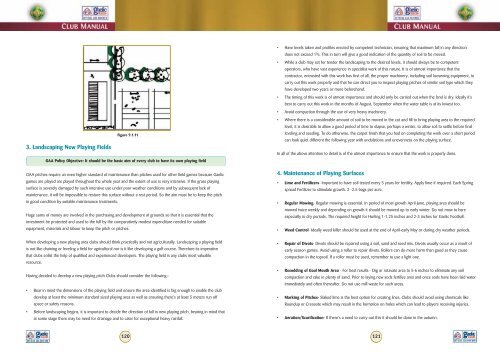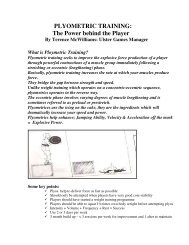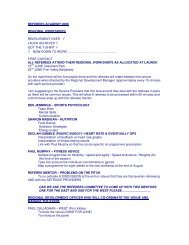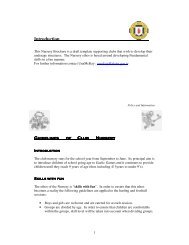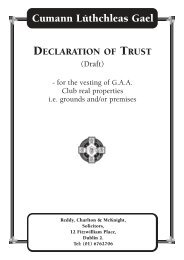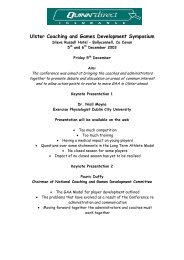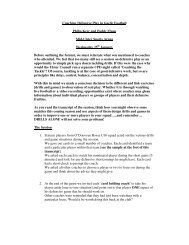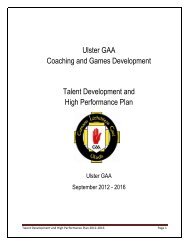Club Manual - Ulster GAA
Club Manual - Ulster GAA
Club Manual - Ulster GAA
Create successful ePaper yourself
Turn your PDF publications into a flip-book with our unique Google optimized e-Paper software.
3. Landscaping New Playing Fields<br />
Figure 9.1.11<br />
<strong>GAA</strong> Policy Objective: It should be the basic aim of every club to have its own playing field<br />
<strong>GAA</strong> pitches require an even higher standard of maintenance than pitches used for other field games because Gaelic<br />
games are played are played throughout the whole year and the extent of use is very intensive. If the grass playing<br />
surface is severely damaged by such intensive use under poor weather conditions and by subsequent lack of<br />
maintenance, it will be impossible to restore this surface without a rest period. So the aim must be to keep the pitch<br />
in good condition by suitable maintenance treatments.<br />
Huge sums of money are involved in the purchasing and development of grounds so that it is essential that the<br />
investment be protected and used to the full by the comparatively modest expenditure needed for suitable<br />
equipment, materials and labour to keep the pitch or pitches.<br />
When developing a new playing area clubs should think practically and not agriculturally. Landscaping a playing field<br />
is not like draining or leveling a field for agricultural nor is it like developing a golf course. Therefore its imperative<br />
that clubs enlist the help of qualified and experienced developers. The playing field is any clubs most valuable<br />
resource.<br />
Having decided to develop a new playing pitch <strong>Club</strong>s should consider the following:-<br />
• Bear in mind the dimensions of the playing field and ensure the area identified is big enough to enable the club<br />
develop at least the minimum standard sized playing area as well as ensuring there’s at least 5 meters run off<br />
space or safety reasons.<br />
• Before landscaping begins, it is important to decide the direction of fall in new playing pitch, bearing in mind that<br />
at some stage there may be need for drainage and to cater for exceptional heavy rainfall.<br />
• Have levels taken and profiles erected by competent technician, ensuring that maximum fall in any direction<br />
does not exceed 1%. This in turn will give a good indication of the quantity of soil to be moved.<br />
• While a club may set for tender the landscaping to the desired levels, it should always be to competent<br />
operators, who have vast experience in specialist work of this nature. It is of utmost importance that the<br />
contractor, entrusted with this work has first of all, the proper machinery, including soil loosening equipment, to<br />
carry out this work properly and that he can direct you to inspect playing pitches of similar soil type which they<br />
have developed two years or more beforehand.<br />
• The timing of this work is of utmost importance and should only be carried out when the land is dry. Ideally it’s<br />
best to carry out this work in the months of August, September when the water table is at its lowest too.<br />
• Avoid compaction through the use of very heavy machinery.<br />
• Where there is a considerable amount of soil to be moved in the cut and fill to bring playing area to the required<br />
level, it is desirable to allow a good period of time to elapse, perhaps a winter, to allow soil to settle before final<br />
leveling and seeding. To do otherwise, the carpet finish that you had on completing the work over a short period<br />
can look quiet different the following year with undulations and unevenness on the playing surface.<br />
In all of the above attention to detail is of the utmost importance to ensure that the work is properly done.<br />
4. Maintenance of Playing Surfaces<br />
• Lime and Fertilizers- Important to have soil tested every 5 years for fertility. Apply lime if required. Each Spring<br />
spread Fertilizer to stimulate growth. 2 -2.5 bags per acre.<br />
• Regular Mowing- Regular mowing is essential. In period of most growth April-June, playing area should be<br />
mowed twice weekly and depending on growth it should be mowed up to early winter. Do not mow to bare<br />
especially in dry periods. The required height for Hurling 1-1.25 inches and 2-3 inches for Gaelic Football.<br />
• Weed Control- Ideally weed killer should be used at the end of April-early May or during dry weather periods.<br />
• Repair of Divots- Divots should be repaired using a soil, sand and seed mix. Divots usually occur as a result of<br />
early season games. Avoid using a roller to repair divots. Rollers can do more harm than good as they cause<br />
compaction in the topsoil. If a roller must be used, remember to use a light one.<br />
• Resodding of Goal Mouth Area - For best results - Dig or rotavate area to 5-6 inches to eliminate any soil<br />
compaction and rake in plenty of sand. Prior to laying new sods fertilize area and once sods have been laid water<br />
immediately and often thereafter. Do not use mill waste for such areas.<br />
• Marking of Pitches- Slaked lime is the best option for creating lines. <strong>Club</strong>s should avoid using chemicals like<br />
Roundup or Creosote which may result in the formation on holes which can lead to players receiving injuries.<br />
• Aeration/Scarification- If there’s a need to carry out this it should be done in the autumn.<br />
120<br />
121


